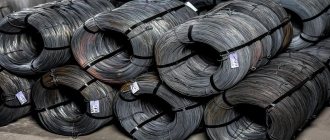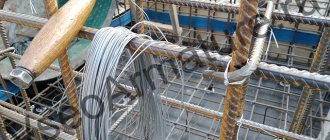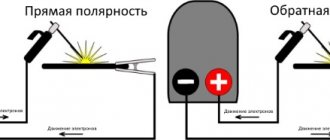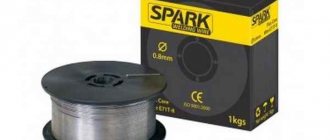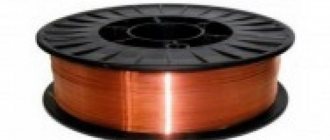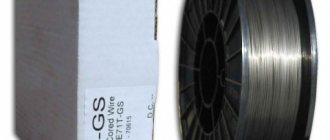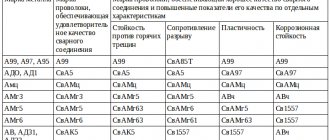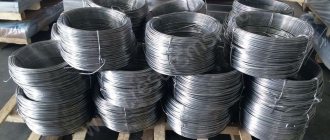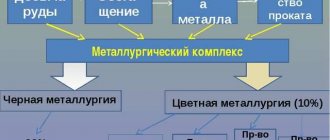What wire is used to tie reinforcement cages?
Knitting wire with diameters of 0.8, 1, 1.2, 1.4, 1.6, 1.8, 2 mm is used to connect reinforcing bars into flat and three-dimensional frames; the weight of 1 linear meter is in the range of 0.004-0.025 kg.
When carrying out reinforcing work, wire is used after annealing, which increases the ductility of the metal product. Depending on the method of heat treatment, products with a light or black surface are distinguished.
- Bright annealing. It is carried out in an environment of inert gases without the presence of oxygen. The surface of such products is clean, not contaminated with scale.
- Black annealing. Occurs in air, so there are oxides on the surface. Such wire gets very dirty on your hands, but its technical parameters do not differ from the properties of rolled products after bright annealing.
Wire without heat treatment has low ductility and breaks easily when knitting, so when using it, a large amount of waste is formed.
For use in aggressive environments, zinc-coated rolled steel is used. There are products with coating classes Ts1 and Ts2. The weight of 1 m of knitting wire with and without coating is assumed to be the same. To increase the service life of metal products, in addition to the zinc layer, polymer coatings of different colors are applied.
How much does a coil of tying wire weigh?
To determine the weight of a long-rolled coil, you need to know the footage and diameter of the wire. The mass of 1 m of a product is determined by its diameter in one of the following ways: using online calculators, using a table or using a formula. By multiplying the weight of 1 m of metal products by the number of meters, the total weight of the coil is obtained.
Types of wire
The most widely used wire is steel. It is classified according to its scope and characteristic features:
- general purpose wire, material – low carbon steel (nail production),
- stainless steel wire, material – heat-resistant, corrosion-resistant alloy, hardware production;
- galvanized wire, material – galvanized steel, production of springs, cables, electrodes, etc., resistant to environmental influences, variety – rope wire for harsh operating conditions, spring – with high elasticity and strength,
- the reinforcing wire has a special surface shape that promotes stronger adhesion to concrete,
- knitting wire, material – low-carbon steel, feature – high ductility, produced by passing through a drawing machine.
Table of weights of binding wire of various diameters
| Diameter, mm | Weight 1 m, kg | Diameter, mm | Weight 1 m, kg | Diameter, mm | Weight 1 m, kg |
| 0,6 | 0,0022 | 2,0 | 0,0247 | 4,0 | 0,0986 |
| 0,8 | 0,00395 | 2,2 | 0,030 | 4,5 | 0,1249 |
| 1,0 | 0,00617 | 2,5 | 0,039 | 5,0 | 0,1541 |
| 1,2 | 0,00888 | 2,8 | 0,048 | 5,5 | 0,1865 |
| 1,4 | 0,0121 | 3,0 | 0,0555 | 6,0 | 0,222 |
| 1,6 | 0,0153 | 3,2 | 0,0631 | 6,3 | 0,2447 |
| 1,8 | 0,02 | 3,5 | 0,0755 | 7,0 | 0,3021 |
To determine the mass of 1 meter of long products, you can use the formula M = ρ*π*(d2/4) , in which:
- ρ – steel density, 7500 kg/m3;
- π – 3,14;
- d – diameter, m.
The standards indicate the minimum coil weight for binding wire of different diameters. So, for products with diameters of 0.6-1 mm without coating it is 5 kg, 1.1-2 mm - 8 kg, 2.2-3.6 mm - 12 kg, 4-6 mm - 30 kg. The maximum weight of the coil, determined by the standards, is 1500 kg. However, in each individual case, the mass of coils, coils and reels can be set by the customer. There is only one rolled section in one skein, and no more than three in a bay.
In addition to carrying out reinforcement work, long products made from low-carbon steels are used for the manufacture of masonry and plaster mesh, cages and enclosures for animals, tying goods, insulating heating mains, and in the construction of fences.
Weight of steel, copper and aluminum wire - tables and calculation formulas
The weight of the wire is of little concern to most of its consumers, because they purchase this metal product based on the required footage and, in fact, also pay by meters. But this applies only to those who directly use this product and, moreover, in small quantities. But there is another category of consumers - large construction, industrial and manufacturing enterprises, as well as suppliers who either use or sell wire in large volumes, and for them it is extremely necessary to know its weight.
Weight of 1 meter of wire, weight of wire
The weight of 1 meter of steel wire is calculated by the formula:
m=π*R²*р , where
This formula for calculating the mass of wire is applicable to any steel wire: galvanized, spring, rope, knitting and others.
Please note that according to GOST standards, almost any steel wire is manufactured with a “minus” tolerance. That is, the actual diameter, and, accordingly, the actual mass, will be slightly less than the nominal ones.
Table for converting wire mass into length (number of grams in 1 meter of steel wire):
| Wire diameter, mm | Theoretical weight of steel wire, g/m |
| 0.2 | 0.2465 |
| 0.4 | 0.9860 |
| 0.6 | 2.2184 |
| 0.8 | 3.9438 |
| 1.0 | 6.1623 |
| 1.2 | 8.8736 |
| 1.4 | 12.0780 |
| 1.6 | 15.7754 |
| 1.8 | 19.9657 |
| 2.0 | 24.6490 |
| 2.2 | 29.8253 |
| 2.4 | 35.4946 |
| 2.6 | 41.6568 |
| 2.8 | 48.3120 |
| 3.0 | 55.4603 |
| 3.2 | 63.1014 |
| 3.4 | 71.2356 |
| 3.6 | 79.8628 |
| 3.8 | 88.9829 |
| 4.0 | 98.5960 |
| 4.2 | 108.7021 |
| 4.4 | 119.3012 |
| 4.6 | 130.3932 |
| 4.8 | 141.9782 |
| 5.0 | 154.0563 |
| 5.2 | 166.6272 |
| 5.4 | 179.6912 |
| 5.6 | 193.2482 |
| 5.8 | 207.2981 |
| 6.0 | 221.8410 |
| 6.2 | 236.8769 |
| 6.4 | 252.4058 |
| 6.6 | 268.4276 |
| 6.8 | 284.9424 |
| 7.0 | 301.9503 |
| 7.2 | 319.4510 |
| 7.4 | 337.4448 |
| 7.6 | 355.9316 |
| 7.8 | 374.9113 |
| 8.0 | 394.3840 |
If you need to find out the theoretical mass or weight of, for example, aluminum or copper wire, you just need to substitute the density of the desired metal in this formula instead of the density of steel.
We sell various wires and deliver to the following regions:
Yaroslavl, Ekaterinburg, Volzhsky, Bryansk, Taganrog, Orel, Syzran, Norilsk, Mezhdurechensk, Voronezh, Smolensk, Omsk, Belgorod, Neftekamsk, Tomsk, Cherepovets, Novocherkassk, Rybinsk, Volgodonsk, Vorkuta, Magadan, Noyabrsk, St. Petersburg, Stavropol, Yelets, Essentuki, Novokuybyshevsk, Saratov, Khimki, Penza, Nalchik, Krasnodar, Arkhangelsk, Abakan, Kislovodsk, Kostroma, Yoshkar-Ola, Urengoy, Kaliningrad, Lipetsk, Orekhovo-Zuevo, Nefteyugansk, Pskov, Sterlitamak, Nakhodka, Petropavlovsk-Kamchatsky, Angarsk, Astrakhan, Nizhnekamsk, Armavir, Novgorod, Ivanovo, Almetyevsk, Pyatigorsk, Perm, Krasnoyarsk, Miass, Chelyabinsk, Kirov, Ussuriysk, Vladivostok, Nizhnevartovsk, Obninsk, Vladikavkaz, Irkutsk, Kemerovo, Achinsk, Murmansk, Kurgan, Petrozavodsk, Novosibirsk, Ufa, Khabarovsk, Grozny, Tambov, Mytishchi, Orenburg, Ryazan, Novgorod, Kazan, Saransk, Novorossiysk, Tagil, Krasnogorsk, Sochi, Novokuznetsk, Kovrov, Rostov-on-Don, Barnaul, Vladimir, Ukhta, Kaluga, Kursk, Chita, Nazran, Solikamsk, Syktyvkar, Tyumen, Novouralsk, Blagoveshchensk, Dzerzhinsk, Moscow, Yuzhno-Sakhalinsk, Volgograd, Tver, Bratsk, Yakutsk, Kolomna, Ulan-Ude, Serpukhov, Azov, Ulyanovsk, Izhevsk, Cheboksary, Kamyshin, Elista, Komsomolsk- on-Amur, Odintsovo, Togliatti, Murom, Magnitogorsk, Arzamas, Vologda, Samara, Tobolsk.
Source
Wire consumption
Questions that often concern wire buyers: the weight and consumption of the product for a particular task. Below we provide answers to the most popular questions.
Wire consumption for reinforcement
The consumption of tying wire for reinforcement when arranging the foundation is on average 15-20 kg of wire with a diameter of 3-4 mm per ton of reinforcement. The exact weight of the wire depends on the number of connections.
Calculation of wire for the production of chain-link mesh.
Calculation formula:
Weight (kg) = (13.40 * D2 /A, where 13.40 kg/mm is a constant coefficient; D is the wire diameter in mm; A is the cell diameter in mm). Let's say, if you need to know the consumption of 1.8 mm wire for the production of a Chain-link mesh with a cell of 50 mm, then we get
(13.40*1.8²) /50 = 0.86 kg per 1 sq. m mesh
Knitting wire
View price - Steel wire
Knitting wire is made from low-carbon heat-treated wire in accordance with GOST 3282-74, with diameters from 0.16 mm to 10 mm, in coils, usually up to 100 kg. During annealing, the metal is heated to the recrystallization temperature and then cooled, resulting in annealed light (without scale) and dark wire (with scale). Knitting wire has softness, ductility, elasticity and strength.
Knitting wire is produced in two stages: obtaining the workpiece and drawing. The metal from which the wire is made is rolled and then cold wired. In accordance with the GOST 3282 standard, knitting wire is made from class II wire rod in accordance with OST-14-15-193-86 or other regulatory and technical documentation. It is also allowed to produce wire from low-carbon steel grades in accordance with GOST 1050-74 and wire rods in accordance with GOST 4231-70.
Knitting wire is used in agriculture, in everyday life, in construction for tying reinforcement, and for weaving cables. Light-colored wire has a smoother surface and is used for decorative decorations, as well as for the production of mesh. The dark oxide layer is not a defect and does not affect the properties of the wire to tie reinforcement cages. Knitting wire serves as raw material for the production of galvanized soft and hard wire.
Knitting wire 1.2 mm is used to connect metal elements and structural parts before welding, to hold the structure during welding work.
General purpose low-carbon steel wire GOST 3282-74 is divided into:
1. by type of processing - heat treated - O - not heat treated
2. by type of surface: a) with a diameter from 0.16 to 10 mm - without coating: - light - C - black - B b) with a diameter of 0.20 - 6 mm - coated - galvanized 1st class - 1C - galvanized 2nd class — 2C
3. in terms of manufacturing accuracy: - increased accuracy - P - normal accuracy
4. by temporary tensile strength (for heat-treated wire) - 1st group - I - 2nd group - II
Table. Range of low-carbon steel wire GOST 3282 (range of binding wire)
| Wire diameter, mm | Weight of wire in a coil or on a reel, kg, not less | Theoretical weight of wire, weight per linear meter, kg in m | |
| Without cover | galvanized | ||
| 0,8 | 5 | 0,6 | 0,0039 |
| 1,0 | 5 | 0,6 | 0,0062 |
| 1,2 | 8 | 2 | 0,0088 |
| 2,0 | 8 | 2 | 0,0246 |
| 3,0 | 12 | 5 | 0,056 |
| 4,0 | 30 | 10 | 0,099 |
| 5,0 | 30 | 10 | 0,154 |
| 6,0 | 30 | 10 | 0,222 |
Manufacturers of annealed wire: OJSC West Siberian Metallurgical Plant, LLC Siversky Hardware.
Buy steel wire
From us you can buy knitting wire from the warehouses of branches, 3 warehouses in the Moscow region or directly from the factory. We provide services for cutting, delivery and assembly of wire. Availability, assortment and cost can be found on the website. For more detailed information on the price per meter, calculate the quantity, issue an invoice and fill out an application, clarify payment options and request a certificate for the received metal, please contact the manager by contacting him by phone:
(8452) 57-00-18, e-mail: [email protected]
Weight of 1 meter of wire, dimensions and weight of the coil, number of meters in a coil
Reference information on the theoretical weight of a linear meter and the dimensions of coils of low-carbon steel wire according to GOST 3282:
| f, mm | Hank weight, kg | External f of the skein, mm | Internal f of the skein, mm | Weight 1m/linear. kg, not ots | Weight 1m/linear. kg, ots | Coil weight (mass), kg |
| 0,5 | 15 — 20 | 350-400 | 150-200 | 0,0015 | ||
| 0,6 | 20 — 25 | 400 | 200 | 0,0021 | 15-20 | |
| 0,7 | 25 — 30 | 400 | 150-200 | |||
| 0,8 | 30 — 70 | 350-500 | 150-200 | 0,004 | 22-30 | |
| 0,9 | 80 — 100 | 350-500 | 200 | 0,005 | 23-30 | |
| 1,0 | 80 — 130 | 500 | 250-450 | 0,006 | 0,0058 | 57-100 |
| 1,2 | 80 — 130 | 450-800 | 400-450 | 0,009 | 0,0094 | 50-120 |
| 1,25 | 120-160 | 750-800 | 400-450 | 0,0099 | 70-90 | |
| 1,4 | 120-160 | 750-800 | 400-450 | 0,012 | 0,0125 | 150-180 |
| 1,6 | 120-180 | 750-800 | 400-450 | 0,015 | 100-170 | |
| 1,8 | 120-180 | 800 | 400 | 0,019 | 0,0198 | 89-160 |
| 2,0 | 150-180 | 800 | 400 | 0,024 | 0,025 | 100-150 |
| 2,1 | 150-180 | 800 | 400 | 0,028 | ||
| 2,4 | 150-180 | 800 | 400 | 0,0312 | ||
| 2,5 | 150-180 | 800 | 400 | 0,039 | 0,405 | 100-150 |
| 2,8 | 150-180 | 800 | 400 | 0,0447 | ||
| 3,0 | 150-180 | 800 | 400 | 0,055 | 0,0572 | 130-180 |
| 3,25 | 150-180 | 800 | 400 | 0,0574 | ||
| 3,5 | 150-180 | 800 | 400 | 0,075 | 0,078 | |
| 4,0 | 150-180 | 800 | 400 | 0,099 | 0,1029 | 150-200 |
| 4,5 | 150-180 | 800 | 400 | 0,135 | ||
| 5,0 | 150-180 | 800 | 400 | 0,148 | 0,1601 | 150-220 |
| 6,0 | 150-200 | 750-900 | 450-500 | 0,220 | 0,2308 | 160-250 |
| 8,0 | 900-1200 | 1000 | 500 |
You can get more detailed advice from our specialists.
| Calculate distance between cities | Next > Dimensions of rope drums, weight of wooden drums |
